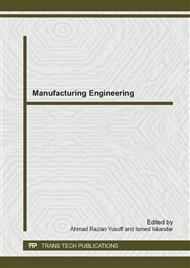p.3
p.9
p.15
p.21
p.27
p.33
p.39
p.45
Effect of Tool Path Strategies in Pocket Milling of Aluminium Epoxy
Abstract:
Selection of the most suitable tool path strategy is very essential during machining especially in computer aided design and manufacture (CAD/CAM) as well as computer numerical control (CNC) machining. Existence of various tool path strategies to be applied on advanced composite materials such as aluminium epoxy required extensive researches in determining the best combination of tool path and cutting parameters for better machinability performance. Pocket milling of aluminium epoxy specimen via CAD/CAM was conducted in this study to investigate the effect of three types of tool path strategies namely Inward Helical, Outward Helical and Back and Forth. Uncoated high speed steel (HSS-Co8) ball end mill was used throughout the experiments. The machining responses that were evaluated include machining time, tool wear rate, tool life and surface finish of the machined pockets. In general, the effect of tool path strategy was highly significant on the machining responses and results showed that Back and Forth strategy offered the best machinability results when compared to the other strategies.
Info:
Periodical:
Pages:
15-20
Citation:
Online since:
February 2014
Keywords:
Price:
Сopyright:
© 2014 Trans Tech Publications Ltd. All Rights Reserved
Share:
Citation:


